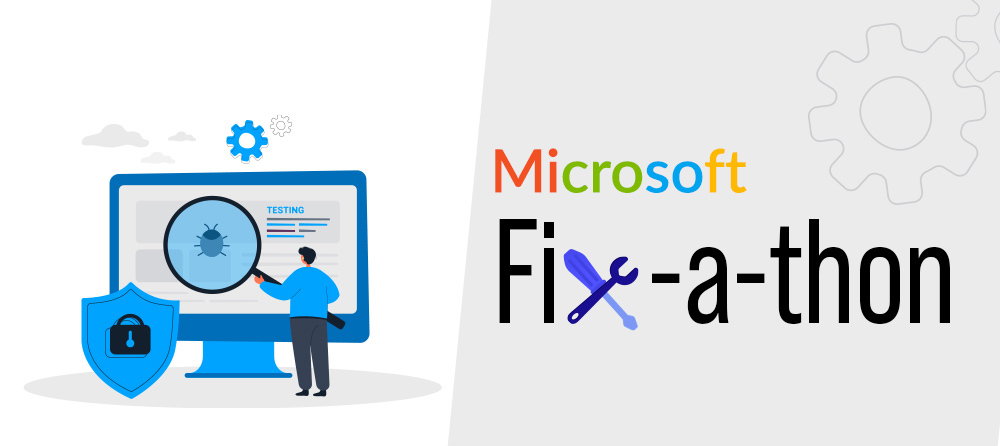Microsoft Fix-a-thon
Last Updated :
15 Jul, 2022
Microsoft conducts Fix-a-thon for hiring final year college students for the role of Support Engineering interns. Support engineers are part of Microsoft’s Customer Experience & Success (CE&S) team.

What is Customer Experience and Success (CE&S)?
Microsoft Customer Experience and Success (CE&S) is the company’s technical support division, formerly known as Microsoft Customer Service and Support (CSS). Support engineers, managers, technical advisors, and a variety of other professions make up the team, all of whom are dedicated to improving the customer experience and assisting customers with a variety of issues.
Who are Support Engineers?
Support Engineers (SE) provide technical support to Microsoft’s customers and partners via phone, email, and the web. They add value by collectively and reactively resolving customer issues, offering proactive support advice, contributing to product quality and enhancements, and developing self-help assets to reach a wider audience. They are a member of a team that is responsible for providing exceptional technical assistance to our commercial customers. They own and control the client experience via the phone and on the web, from problem detection to complete resolution. When necessary, they work with others to enlist the help of subject matter experts, engineers, or management.
Eligibility Criteria for Fix-a-thon :
- Students who are pursuing BE/B.Tech in CSE/IT/other quantitative branches.
- CGPA above 8 in the current degree.
- Degree Completion year should be current year(last year of Graduation).
- Candidate should not have participated in any Microsoft hiring event in the last 12 months.
Recruitment Process :
- Resume Screening
- Online assessment and Video Submission
- Training modules and break-fix challenge
- Team hackathon
- Interview Rounds
Resume Screening round: Incorporates basic information about you and your skills, achievements and extra-curriculars. Because this is the initial step in the shortlisting process, make sure you prepare it as well as you can. Students are shortlisted for the next phase based on their application forms. There were around 11000+ candidates from different colleges across India.
Online assessment and Video Submission: Online assessment was based upon core Computer Science subjects like Operating Systems, Database Management System, Computer networks, data structures and algorithm and aptitude(Quantitative + Verbal + Logical Reasoning). You can also expect some questions pertaining to Microsoft products as well. There were only MCQs and no coding questions. The questions were of easy to medium standard of difficulty. Candidates who were selected for the assessment were required to upload a video explaining who they are, why they want to intern with Microsoft, and why they would be a good fit for Microsoft’s support engineering role. Out of 11000 applicants around 100 were shortlisted for the next phase.
Training modules and break-fix challenge: This is the most unique and interesting phase of the whole recruitment journey. The 100 shortlisted candidates went through learning modules over a 5 day period. We were trained on windows as an operating system, computer networks, cloud computing and Microsoft Azure. Unlike a typical college curriculum these learning modules dealt with the practical approach of the concepts. The best part of these trainings were that the non-CS students could also get deep insights on the CS fundamentals. The trainings were provided by highly experienced Subject Matter Experts(SMEs) of Microsoft. Now comes the most interesting part- the break-fix challenge. This round was conducted via Microsoft Teams. Every candidate was aligned to an interviewer who had a set of tasks that we needed to perform on our virtual machines created on Azure while sharing the screen. The tasks mainly revolved around basic troubleshooting on some common issues. For example, the internet on our virtual machine is not working due to some issue. So we needed to explain and carry out the steps we needed to perform to remove the problem. Around 50 qualified for the next round.
Team hackathon: 50 students were split into ten groups of five students each. Each team was given a problem statement based on current events, which we had to solve. A mentor was appointed to each team to guide them through their concept and answer any questions they had. For a week, five of us collaborated to find a solution. Our mentor provided invaluable help and guidance throughout the entire process. We had to present our ideas to a panel and based on our presentation 5 out of the 10 teams qualified for the finals of the hackathon. Unfortunately our team didn’t qualify for the finals.
Interview Rounds: Every 50 candidate qualified for the hackathon round was judged on various factors throughout the whole journey. So it didn’t mean end of road for one’s whose team didn’t qualify for finals. Out of 50 candidates around 31 got a chance to sit for the PPO interviews and I was one of them. There were two rounds of interviews. Both were of managerial type. It mainly revolved around basic introduction of myself, my hobbies, the experience so far with Microsoft, how can I contribute to the role being offered, etc.
At the end, candidates selected for internship were notified through emails and fortunately I was among the selected ones. Overall the whole recruitment process was really exciting and one very important thing to remember is, do not make up stuff and answer. Be honest and admit it if you do not have an idea about the question asked.
Like Article
Suggest improvement
Share your thoughts in the comments
Please Login to comment...